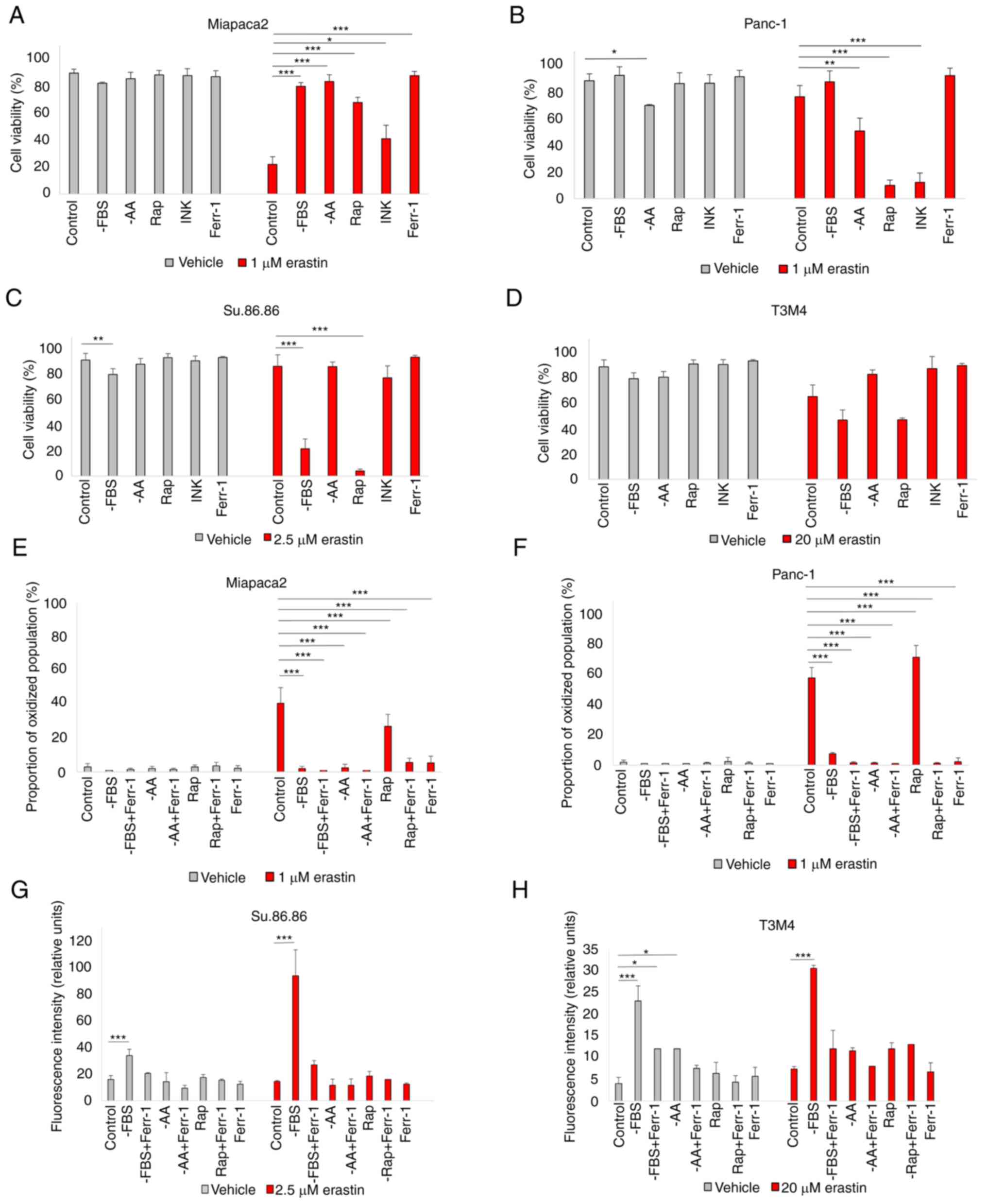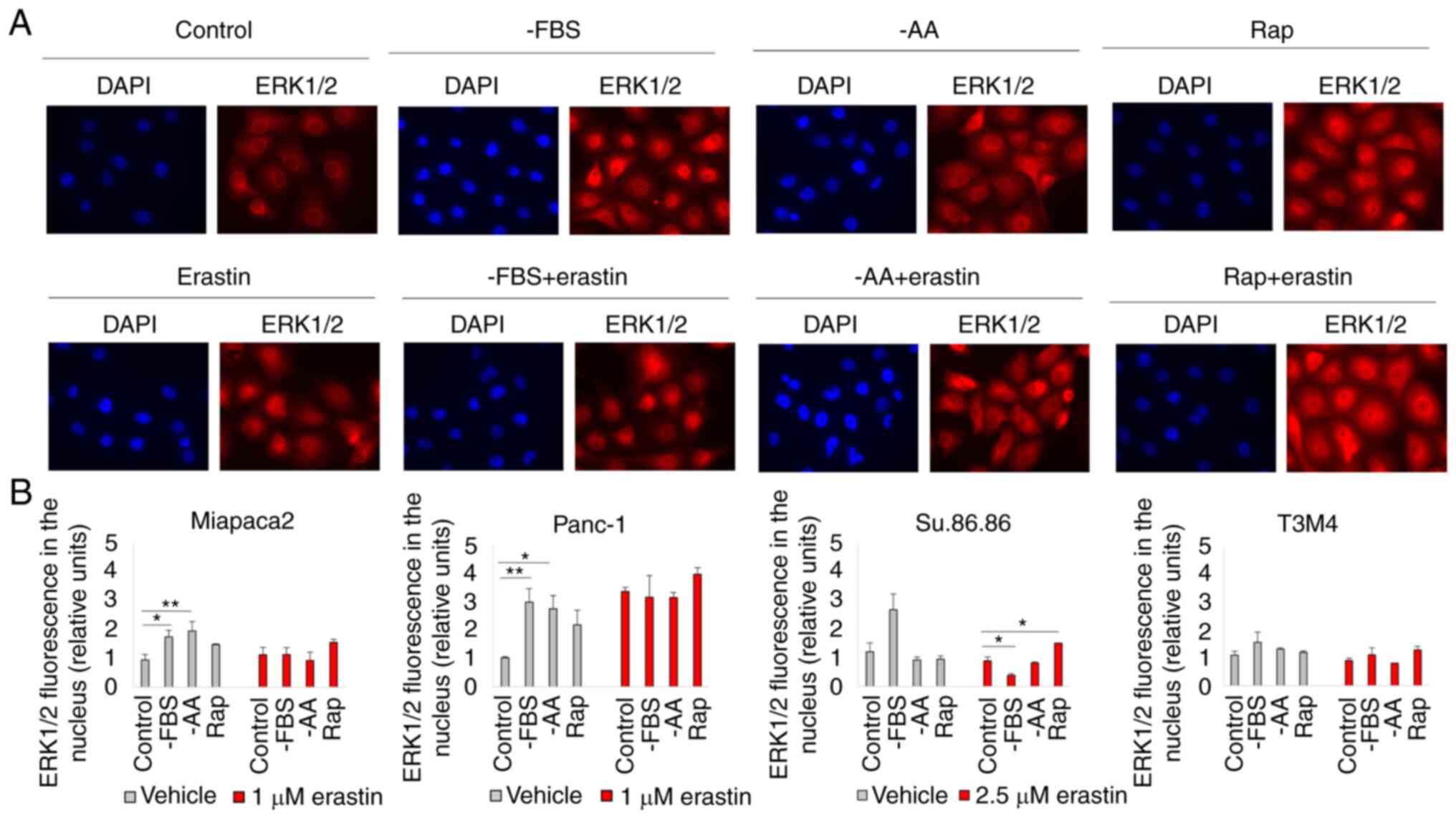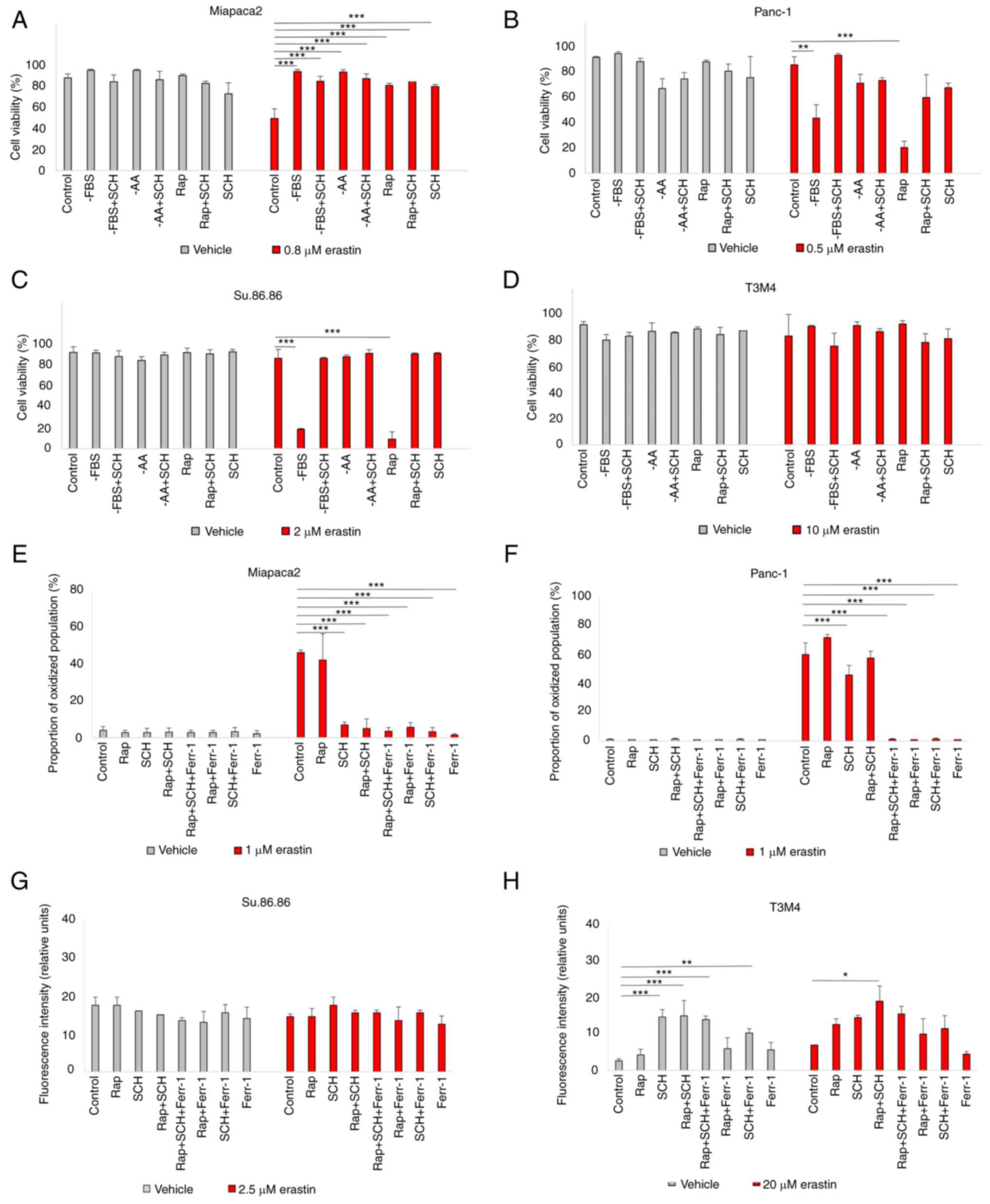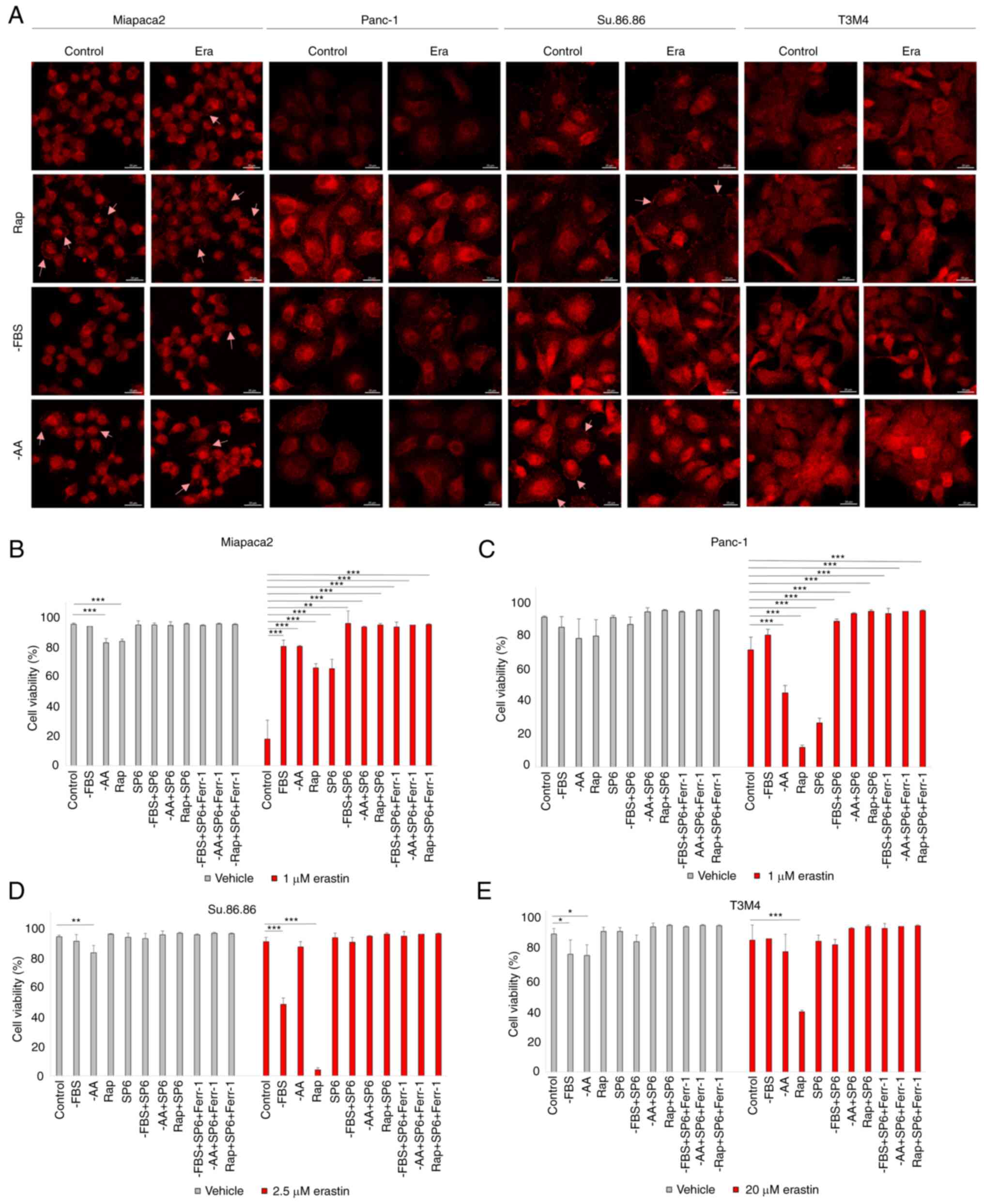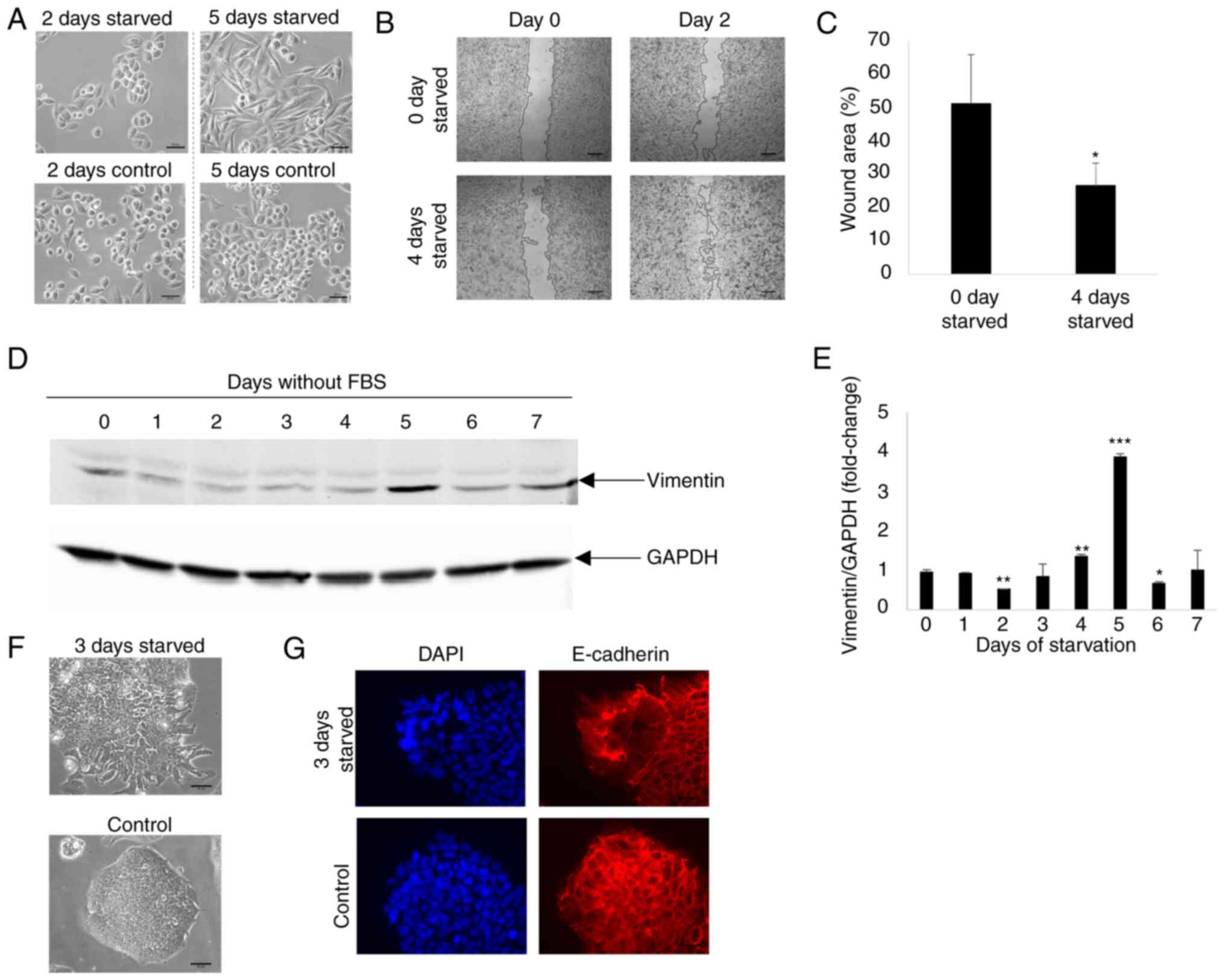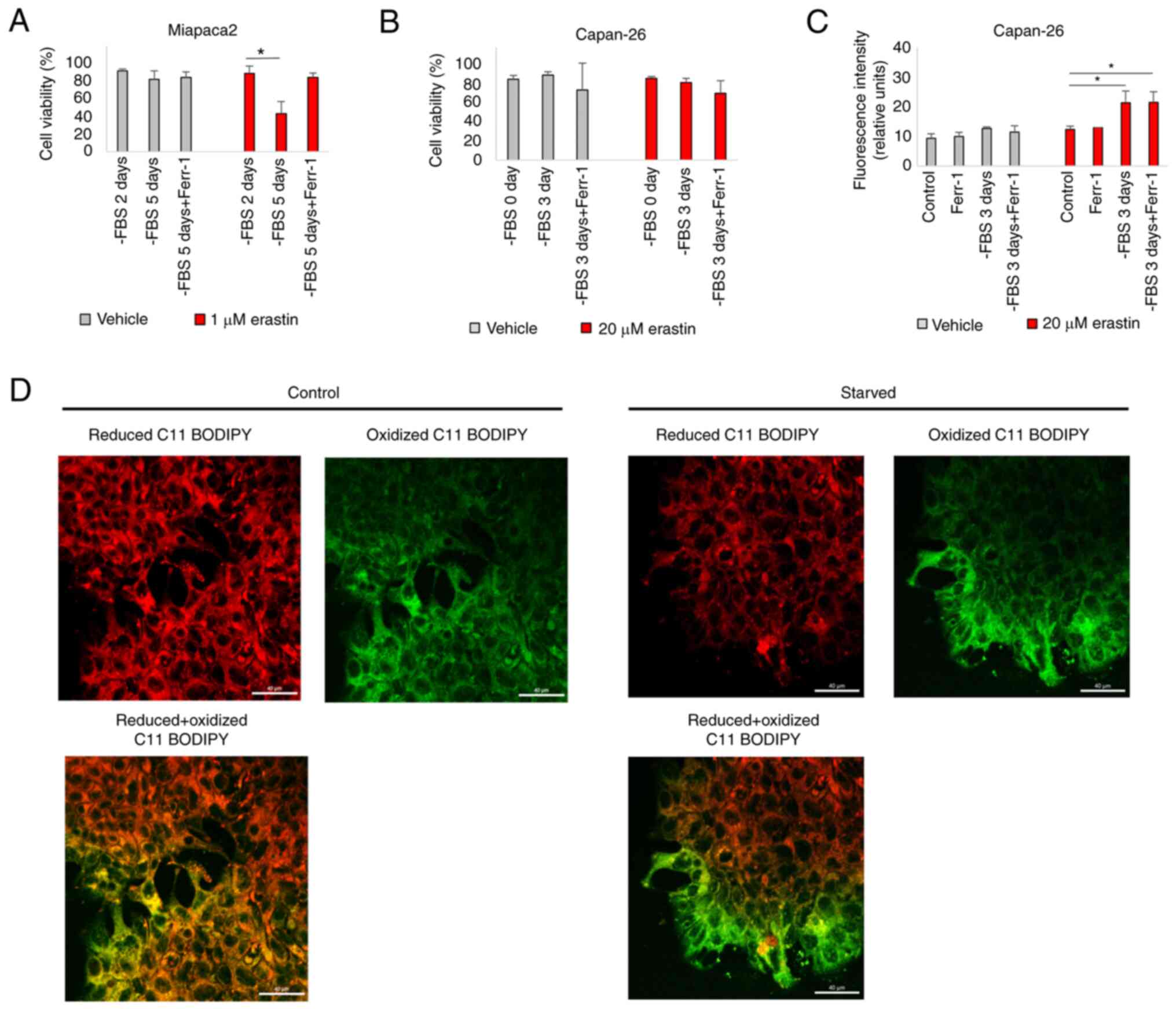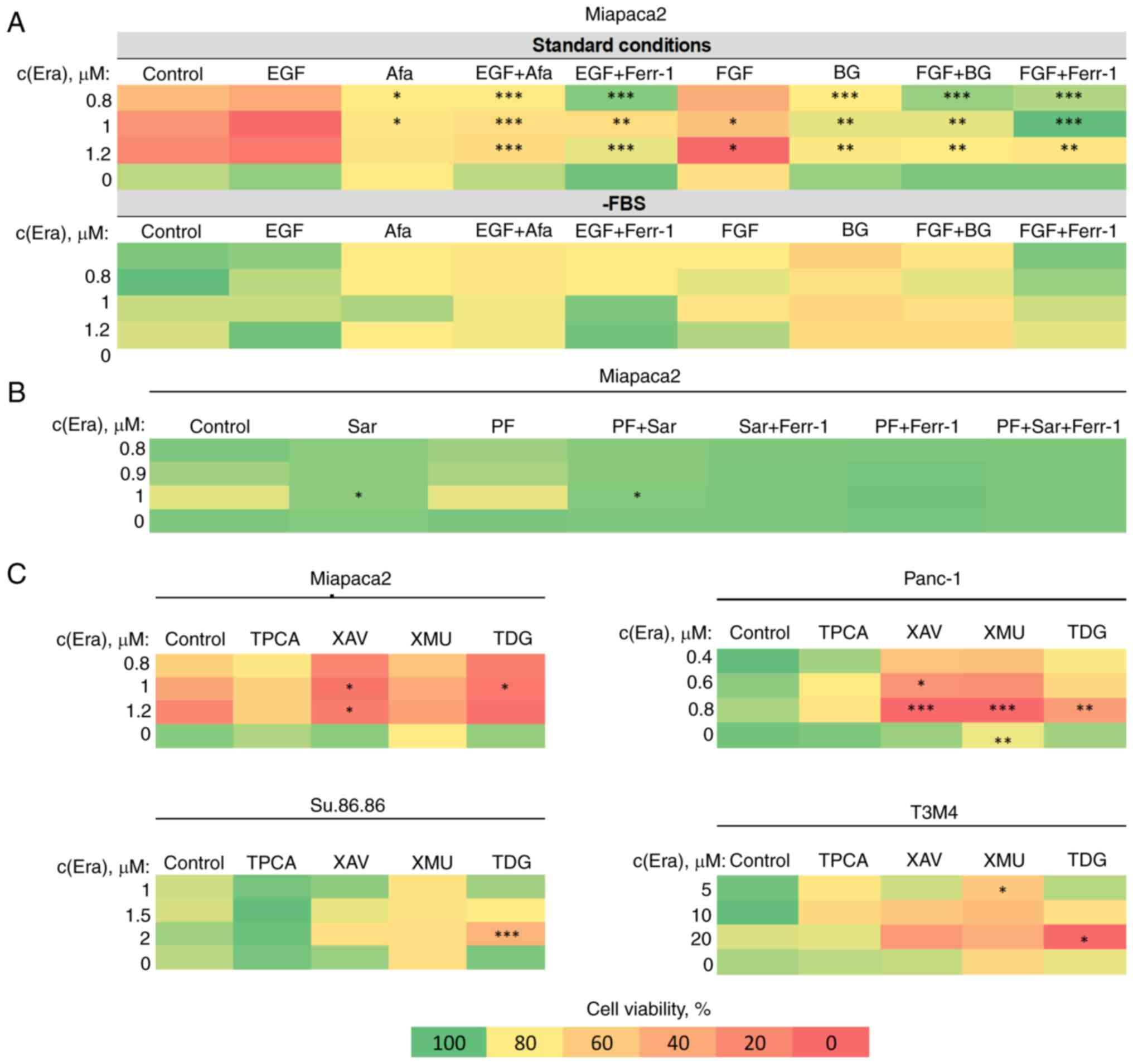|
1
|
Sung H, Ferlay J, Siegel RL, Laversanne M,
Soerjomataram I, Jemal A and Bray F: Global cancer statistics 2020:
GLOBOCAN estimates of incidence and mortality worldwide for 36
cancers in 185 countries. CA Cancer J Clin. 71:209–249. 2021.
View Article : Google Scholar : PubMed/NCBI
|
|
2
|
Spadi R, Brusa F, Ponzetti A, Chiappino I,
Birocco N, Ciuffreda L and Satolli MA: Current therapeutic
strategies for advanced pancreatic cancer: A review for clinicians.
World J Clin Oncol. 7:27–43. 2016. View Article : Google Scholar : PubMed/NCBI
|
|
3
|
Petrillo A, Pappalardo A, Calabrese F,
Tirino G, Pompella L, Ventriglia J, Laterza MM, Caterino M, Sforza
V, Iranzo V, et al: First line nab-paclitaxel plus gemcitabine in
elderly metastatic pancreatic patients: A good choice beyond age. J
Gastroint Oncol. 10:910–917. 2019. View Article : Google Scholar
|
|
4
|
Sarabi M, Mais L, Oussaid N, Desseigne F,
Guibert P and De La Fouchardiere C: Use of gemcitabine as a
second-line treatment following chemotherapy with folfirinox for
metastatic pancreatic adenocarcinoma. Oncol Lett. 13:4917–4924.
2017. View Article : Google Scholar : PubMed/NCBI
|
|
5
|
Ferlay J, Partensky C and Bray F: More
deaths from pancreatic cancer than breast cancer in the EU by 2017.
Acta Oncol. 55:1158–1160. 2016. View Article : Google Scholar : PubMed/NCBI
|
|
6
|
Dixon SJ, Lemberg KM, Lamprecht MR, Skouta
R, Zaitsev EM, Gleason CE, Patel DN, Bauer AJ, Cantley AM, Yang WS,
et al: Ferroptosis: An iron-dependent form of nonapoptotic cell
death. Cell. 149:1060–1072. 2012. View Article : Google Scholar : PubMed/NCBI
|
|
7
|
Han C, Liu Y, Dai R, Ismail N, Su W and Li
B: Ferroptosis and its potential role in human diseases. Front
Pharmacol. 11:2392020. View Article : Google Scholar : PubMed/NCBI
|
|
8
|
Basuli D, Tesfay L, Deng Z, Paul B,
Yamamoto Y, Ning G, Xian W, Mckeon F, Lynch M, Crum CP, et al: Iron
addiction: A novel therapeutic target in ovarian cancer. Oncogene.
36:4089–4099. 2017. View Article : Google Scholar : PubMed/NCBI
|
|
9
|
Eling N, Reuter L, Hazin J, Hamacher-Brady
A and Brady NR: Identification of artesunate as a specific
activator of ferroptosis in pancreatic cancer cells. Oncoscience.
2:517–532. 2015. View Article : Google Scholar : PubMed/NCBI
|
|
10
|
Li B, Yang L, Peng X, Fan Q, Wei S, Yang
S, Li X, Jin H, Wu B, Huang M, et al: Emerging mechanisms and
applications of ferroptosis in the treatment of resistant cancers.
Biomed Pharmacother. 130:1107102020. View Article : Google Scholar
|
|
11
|
Gagliardi M, Saverio V, Monzani R, Ferrari
E, Piacentini M and Corazzari M: Ferroptosis: A new unexpected
chance to treat metastatic melanoma? Cell Cycle. 19:2411–2425.
2020. View Article : Google Scholar : PubMed/NCBI
|
|
12
|
Liu H, Schreiber SL and Stockwell BR:
Targeting dependency on the GPX4 lipid peroxide repair pathway for
cancer therapy. Biochemistry. 57:2059–2060. 2018. View Article : Google Scholar : PubMed/NCBI
|
|
13
|
Viswanathan VS, Ryan MJ, Dhruv HD, Gill S,
Eichhoff OM, Seashore-Ludlow B, Kaffenberger SD, Eaton JK, Shimada
K, Aguirre AJ, et al: Dependency of a therapy-resistant state of
cancer cells on a lipid peroxidase pathway. Nature. 547:453–457.
2017. View Article : Google Scholar : PubMed/NCBI
|
|
14
|
Koppula P, Zhuang L and Gan B: Cystine
transporter SLC7A11/xCT in cancer: Ferroptosis, nutrient
dependency, and cancer therapy. Protein Cell. 12:599–620. 2021.
View Article : Google Scholar :
|
|
15
|
Son J, Lyssiotis CA, Ying H, Wang X, Hua
S, Ligorio M, Perera RM, Ferrone CR, Mullarky E, Shyh-Chang N, et
al: Glutamine supports pancreatic cancer growth through a
KRAS-regulated metabolic pathway. Nature. 496:101–105. 2013.
View Article : Google Scholar : PubMed/NCBI
|
|
16
|
Liu Q, Zhang H, Jiang X, Qian C, Liu Z and
Luo D: Factors involved in cancer metastasis: A better
understanding to 'seed and soil' hypothesis. Mol Cancer.
16:1762017. View Article : Google Scholar
|
|
17
|
Ni B, Ghosh B, Paldy FS, Colin R, Heimerl
T and Sourjik V: Evolutionary remodeling of bacterial motility
checkpoint control. Cell Rep. 18:866–877. 2017. View Article : Google Scholar : PubMed/NCBI
|
|
18
|
Gancedo JM: Control of pseudohyphae
formation in Saccharomyces cerevisiae. FEMS Microbiol Rev.
25:107–123. 2001. View Article : Google Scholar : PubMed/NCBI
|
|
19
|
Keenan MM and Chi JT: Alternative fuels
for cancer cells. Cancer J. 21:49–55. 2015. View Article : Google Scholar : PubMed/NCBI
|
|
20
|
Commisso C, Davidson SM, Soydaner-Azeloglu
RG, Parker SJ, Kamphorst JJ, Hackett S, Grabocka E, Nofal M, Drebin
JA, Thompson CB, et al: Macropinocytosis of protein is an amino
acid supply route in Ras-transformed cells. Nature. 497:633–637.
2013. View Article : Google Scholar : PubMed/NCBI
|
|
21
|
Martinez-Outschoorn UE, Lisanti MP and
Sotgia F: Catabolic cancer-associated fibroblasts transfer energy
and biomass to anabolic cancer cells, fueling tumor growth. Semin
Cancer Biol. 25:47–60. 2014. View Article : Google Scholar : PubMed/NCBI
|
|
22
|
Yang S, Wang X, Contino G, Liesa M, Sahin
E, Ying H, Bause A, Li Y, Stommel JM, Dell'antonio G, et al:
Pancreatic cancers require autophagy for tumor growth. Genes Devel.
25:717–729. 2011. View Article : Google Scholar : PubMed/NCBI
|
|
23
|
Lugano R, Ramachandran M and Dimberg A:
Tumor angiogenesis: Causes, consequences, challenges and
opportunities. Cell Mol Life Sci. 77:1745–1770. 2020. View Article : Google Scholar :
|
|
24
|
Prabhakar NR and Semenza GL: Adaptive and
maladaptive cardiorespiratory responses to continuous and
intermittent hypoxia mediated by hypoxia-inducible factors 1-2.
Physiol Rev. 92:967–1003. 2012. View Article : Google Scholar : PubMed/NCBI
|
|
25
|
Kuczynski EA, Vermeulen PB, Pezzella F,
Kerbel RS and Reynolds AR: Vessel co-option in cancer. Nat Rev Clin
Oncol. 16:469–493. 2019. View Article : Google Scholar : PubMed/NCBI
|
|
26
|
Neophytou CM, Panagi M, Stylianopoulos T
and Papageorgis P: The role of tumor microenvironment in cancer
metastasis: Molecular mechanisms and therapeutic opportunities.
Cancers (Basel). 13:20532021. View Article : Google Scholar
|
|
27
|
Janssen LME, Ramsay EE, Logsdon CD and
Overwijk WW: The immune system in cancer metastasis: Friend or foe?
J Immunotherapy Cancer. 5:792017. View Article : Google Scholar
|
|
28
|
Wang RA, Lu YY and Fan DM: Reasons for
cancer metastasis: A holistic perspective. Mol Clin Oncol.
3:1199–1202. 2015. View Article : Google Scholar
|
|
29
|
Trauzold A, Siegmund D, Schniewind B,
Sipos B, Egberts J, Zorenkov D, Emme D, Röder C, Kalthoff H and
Wajant H: TRAIL promotes metastasis of human pancreatic ductal
adenocarcinoma. Oncogene. 25:7434–7439. 2006. View Article : Google Scholar : PubMed/NCBI
|
|
30
|
Jiao D, Cai Z, Choksi S, Ma D, Choe M,
Kwon HN, Baik JY, Rowan BG, Liu C and Liu ZG: Necroptosis of tumor
cells leads to tumor necrosis and promotes tumor metastasis. Cell
Res. 28:868–870. 2018. View Article : Google Scholar : PubMed/NCBI
|
|
31
|
Zalyte E, Dedonyte V, Kurlinkus B,
Sileikis A, Schemmer P and Valius M: Establishment and
characterization of a new pancreatic ductal adenocarcinoma cell
line capan-26. Anticancer Res. 41:1401–1406. 2021. View Article : Google Scholar : PubMed/NCBI
|
|
32
|
Ger M, Žalytė E, Kaupinis A, Kurlinkus B,
Petrulionis M, Šileikis A, Strupas K and Valius M: Primary
pancreatic ductal adenocarcinoma cell cultures represent the
features of native tumours. Biologija. 65:20–33. 2019. View Article : Google Scholar
|
|
33
|
Rabanal-Ruiz Y, Otten EG and Korolchuk VI:
mTORC1 as the main gateway to autophagy. Essays Biochem.
61:565–584. 2017. View Article : Google Scholar : PubMed/NCBI
|
|
34
|
Soares HP, Ni Y, Kisfalvi K, Sinnett-Smith
J and Rozengurt E: Different patterns of Akt and ERK feedback
activation in response to rapamycin, active-site mTOR inhibitors
and metformin in pancreatic cancer cells. PLoS One. 8:e572892013.
View Article : Google Scholar : PubMed/NCBI
|
|
35
|
Liou GY, Döppler H, DelGiorno KE, Zhang L,
Leitges M, Crawford HC, Murphy MP and Storz P: Mutant kras-induced
mitochondrial oxidative stress in acinar cells upregulates EGFR
signaling to drive formation of pancreatic precancerous lesions.
Cell Rep. 14:2325–2336. 2016. View Article : Google Scholar : PubMed/NCBI
|
|
36
|
Palmieri VO, Grattagliano I and Palasciano
G: Ethanol induces secretion of oxidized proteins by pancreatic
acinar cells. Cell Biol Toxicol. 23:459–464. 2007. View Article : Google Scholar : PubMed/NCBI
|
|
37
|
Zhu S, Zhang Q, Sun X, Zeh HJ III, Lotze
MT, Kang R and Tang D: HSPA5 regulates ferroptotic cell death in
cancer cells. Cancer Res. 77:2064–2077. 2017. View Article : Google Scholar : PubMed/NCBI
|
|
38
|
White EZ, Pennant NM, Carter JR, Hawsawi
O, Odero-Marah V and Hinton CV: Serum deprivation initiates
adaptation and survival to oxidative stress in prostate cancer
cells. Sci Rep. 10:125052020. View Article : Google Scholar : PubMed/NCBI
|
|
39
|
Lee H, Zandkarimi F, Zhang Y, Meena JK,
Kim J, Zhuang L, Tyagi S, Ma L, Westbrook TF, Steinberg GR, et al:
Energy-stress-mediated AMPK activation inhibits ferroptosis. Nat
Cell Biol. 22:225–234. 2020. View Article : Google Scholar : PubMed/NCBI
|
|
40
|
Wu CA, Chao Y, Shiah SG and Lin WW:
Nutrient deprivation induces the warburg effect through
ROS/AMPK-dependent activation of pyruvate dehydrogenase kinase.
Biochimica et biophysica Acta. 1833:1147–1156. 2013. View Article : Google Scholar : PubMed/NCBI
|
|
41
|
Sato H, Nomura S, Maebara K, Sato K, Tamba
M and Bannai S: Transcriptional control of cystine/glutamate
transporter gene by amino acid deprivation. Biochem Biophysical Res
Communicati. 325:109–116. 2004. View Article : Google Scholar
|
|
42
|
Gu Y, Albuquerque CP, Braas D, Zhang W,
Villa GR, Bi J, Ikegami S, Masui K, Gini B, Yang H, et al: mTORC2
regulates amino acid metabolism in cancer by phosphorylation of the
cystine-glutamate antiporter xCT. Mol Cell. 67:128–138 e127. 2017.
View Article : Google Scholar : PubMed/NCBI
|
|
43
|
Hanawa N, Shinohara M, Saberi B, Gaarde
WA, Han D and Kaplowitz N: Role of JNK translocation to
mitochondria leading to inhibition of mitochondria bioenergetics in
acetaminophen-induced liver injury. J Biol Chem. 283:13565–13577.
2008. View Article : Google Scholar : PubMed/NCBI
|
|
44
|
Win S, Than TA, Le BH, Garcia-Ruiz C,
Fernandez-Checa JC and Kaplowitz N: Sab (Sh3bp5) dependence of JNK
mediated inhibition of mitochondrial respiration in palmitic acid
induced hepatocyte lipotoxicity. J Hepatol. 62:1367–1374. 2015.
View Article : Google Scholar : PubMed/NCBI
|
|
45
|
Lee YH, Govinda B, Kim JC, Kim TI, Lee NH,
Lee JC, Yi HK and Jhee EC: Oxidative stress resistance through
blocking Hsp60 translocation followed by SAPK/JNK inhibition in
aged human diploid fibroblasts. Cell Biochem Funct. 27:35–39. 2009.
View Article : Google Scholar
|
|
46
|
Li XY and Leung PS: Erastin-induced
ferroptosis is a regulator for the growth and function of human
pancreatic islet-like cell clusters. Cell Regen. 9:162020.
View Article : Google Scholar : PubMed/NCBI
|
|
47
|
Yang Y, Lin Z, Han Z, Wu Z, Hua J, Zhong
R, Zhao R, Ran H, Qu K, Huang H, et al: miR-539 activates the
SAPK/JNK signaling pathway to promote ferropotosis in colorectal
cancer by directly targeting TIPE. Cell Death Dis. 7:2722021.
View Article : Google Scholar
|
|
48
|
Kamphorst JJ, Nofal M, Commisso C, Hackett
SR, Lu W, Grabocka E, Vander Heiden MG, Miller G, Drebin JA,
Bar-Sagi D, et al: Human pancreatic cancer tumors are nutrient poor
and tumor cells actively scavenge extracellular protein. Cancer
Res. 75:544–553. 2015. View Article : Google Scholar : PubMed/NCBI
|
|
49
|
Tong H, Yin H, Hossain MA, Wang Y, Wu F,
Dong X, Gao S, Zhan K and He W: Starvation-induced autophagy
promotes the invasion and migration of human bladder cancer cells
via TGF-β1/Smad3-mediated epithelial-mesenchymal transition
activation. J Cell Biochem. 120:5118–5127. 2019. View Article : Google Scholar
|
|
50
|
Stone TW: Dependence and guidance
receptors-DCC and Neogenin-in partial EMT and the actions of serine
proteases. Front Oncol. 10:942020. View Article : Google Scholar : PubMed/NCBI
|
|
51
|
Kim WK, Kwon Y, Jang M, Park M, Kim J, Cho
S, Jang DG, Lee WB, Jung SH, Choi HJ, et al: β-catenin activation
down-regulates cell-cell junction-related genes and induces
epithelial-to-mesenchymal transition in colorectal cancers. Sci
Rep. 9:184402019. View Article : Google Scholar
|
|
52
|
Coppock JD, Vermeer PD, Vermeer DW, Lee
KM, Miskimins WK, Spanos WC and Lee JH: mTOR inhibition as an
adjuvant therapy in a metastatic model of HPV+ HNSCC. Oncotarget.
7:24228–24241. 2016. View Article : Google Scholar : PubMed/NCBI
|
|
53
|
Chan DLH, Segelov E, Wong RS, Smith A,
Herbertson RA, Li BT, Tebbutt N, Price T and Pavlakis N: Epidermal
growth factor receptor (EGFR) inhibitors for metastatic colorectal
cancer. Cochrane Database Syst Rev. 6:CD0070472017.PubMed/NCBI
|
|
54
|
Demkova L and Kucerova L: Role of the
HGF/c-MET tyrosine kinase inhibitors in metastasic melanoma. Mol
Cancer. 17:262018. View Article : Google Scholar : PubMed/NCBI
|
|
55
|
Yu S, Chen Z, Zeng X, Chen X and Gu Z:
Advances in nanomedicine for cancer starvation therapy.
Theranostics. 9:8026–8047. 2019. View Article : Google Scholar : PubMed/NCBI
|
|
56
|
D'Aronzo M, Vinciguerra M, Mazza T,
Panebianco C, Saracino C, Pereira SP, Graziano P and Pazienza V:
Fasting cycles potentiate the efficacy of gemcitabine treatment in
in vitro and in vivo pancreatic cancer models. Oncotarget.
6:18545–18557. 2015. View Article : Google Scholar : PubMed/NCBI
|















